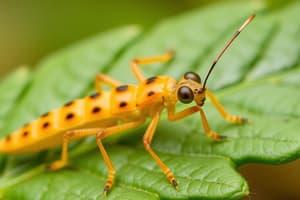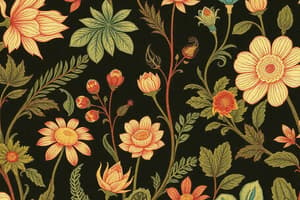Podcast
Questions and Answers
Which characteristic of living things refers to their ability to produce offspring?
Which characteristic of living things refers to their ability to produce offspring?
- Growth
- Response to the environment
- Reproduction (correct)
- Needs
What do living things require to survive?
What do living things require to survive?
- Entertainment and companionship
- Air, food, and water (correct)
- Sunlight and machines
- Shelter and clothing
How do living things respond to their environment?
How do living things respond to their environment?
- By staying completely still
- By moving or altering behavior (correct)
- By changing their habitat
- By growing at an accelerated rate
Which example best illustrates the characteristic of growth in living things?
Which example best illustrates the characteristic of growth in living things?
Which of the following is NOT considered a characteristic of living things?
Which of the following is NOT considered a characteristic of living things?
What is a defining characteristic of flowering plants?
What is a defining characteristic of flowering plants?
How do non-flowering plants propagate?
How do non-flowering plants propagate?
Which of the following is an example of a flowering plant?
Which of the following is an example of a flowering plant?
What type of plant reproduces through spores rather than seeds?
What type of plant reproduces through spores rather than seeds?
Where are spore bags located in non-flowering plants?
Where are spore bags located in non-flowering plants?
What is a key characteristic that differentiates mammals from other animal groups?
What is a key characteristic that differentiates mammals from other animal groups?
Which group of animals is characterized by having moist skin?
Which group of animals is characterized by having moist skin?
What unique feature do insects possess that is not found in mammals or birds?
What unique feature do insects possess that is not found in mammals or birds?
How do reptiles primarily reproduce?
How do reptiles primarily reproduce?
Which of the following statements is true about fish?
Which of the following statements is true about fish?
How do fungi primarily reproduce?
How do fungi primarily reproduce?
What is a major characteristic of birds that distinguishes them from mammals?
What is a major characteristic of birds that distinguishes them from mammals?
Which group includes animals that are able to live both on land and in water during different life stages?
Which group includes animals that are able to live both on land and in water during different life stages?
Which of the following statements about fungi is incorrect?
Which of the following statements about fungi is incorrect?
What is the primary method of breathing for amphibians as adults?
What is the primary method of breathing for amphibians as adults?
What beneficial role do fungi play in the environment?
What beneficial role do fungi play in the environment?
Which of the following fungi is known for its culinary use?
Which of the following fungi is known for its culinary use?
Which disease is caused by certain types of fungi?
Which disease is caused by certain types of fungi?
What process do fungi use to break down dead matter?
What process do fungi use to break down dead matter?
Which of the following is a way fungi can be beneficial?
Which of the following is a way fungi can be beneficial?
Which characteristic is NOT true for fungi?
Which characteristic is NOT true for fungi?
What type of environment do most fungi prefer to grow?
What type of environment do most fungi prefer to grow?
Which of the following fungi is considered harmful?
Which of the following fungi is considered harmful?
What process do bacteria use to break down dead matter into simpler substances?
What process do bacteria use to break down dead matter into simpler substances?
Which of the following is an example of a useful bacterium?
Which of the following is an example of a useful bacterium?
What characteristic is true for most bacteria regarding nutrition?
What characteristic is true for most bacteria regarding nutrition?
Which statement about harmful bacteria is correct?
Which statement about harmful bacteria is correct?
How do oil-consuming bacteria contribute to the environment?
How do oil-consuming bacteria contribute to the environment?
Flashcards
Growth
Growth
Living things increase in size and complexity.
Needs
Needs
Living things need air, food, and water to survive.
Reproduction
Reproduction
Living things make more of their own kind.
Response to environment
Response to environment
Signup and view all the flashcards
Living things
Living things
Signup and view all the flashcards
Flowering Plant
Flowering Plant
Signup and view all the flashcards
Non-Flowering Plant
Non-Flowering Plant
Signup and view all the flashcards
Fruit
Fruit
Signup and view all the flashcards
Spore
Spore
Signup and view all the flashcards
Spore Bag
Spore Bag
Signup and view all the flashcards
Mammals
Mammals
Signup and view all the flashcards
Fish
Fish
Signup and view all the flashcards
Amphibians
Amphibians
Signup and view all the flashcards
Insects
Insects
Signup and view all the flashcards
Reptiles
Reptiles
Signup and view all the flashcards
What's unique about mammals?
What's unique about mammals?
Signup and view all the flashcards
How do insects breathe?
How do insects breathe?
Signup and view all the flashcards
What do fungi use to reproduce?
What do fungi use to reproduce?
Signup and view all the flashcards
What do fungi eat?
What do fungi eat?
Signup and view all the flashcards
What makes fungi useful?
What makes fungi useful?
Signup and view all the flashcards
What harm can fungi cause?
What harm can fungi cause?
Signup and view all the flashcards
Where do fungi thrive?
Where do fungi thrive?
Signup and view all the flashcards
Fungi reproduce
Fungi reproduce
Signup and view all the flashcards
Fungi and food
Fungi and food
Signup and view all the flashcards
Useful Fungi
Useful Fungi
Signup and view all the flashcards
Harmful Fungi
Harmful Fungi
Signup and view all the flashcards
Decomposition
Decomposition
Signup and view all the flashcards
Bacteria's Food
Bacteria's Food
Signup and view all the flashcards
What are Bacteria?
What are Bacteria?
Signup and view all the flashcards
Harmful Bacteria
Harmful Bacteria
Signup and view all the flashcards
Bacteria's Role
Bacteria's Role
Signup and view all the flashcards
Useful Bacteria
Useful Bacteria
Signup and view all the flashcards




